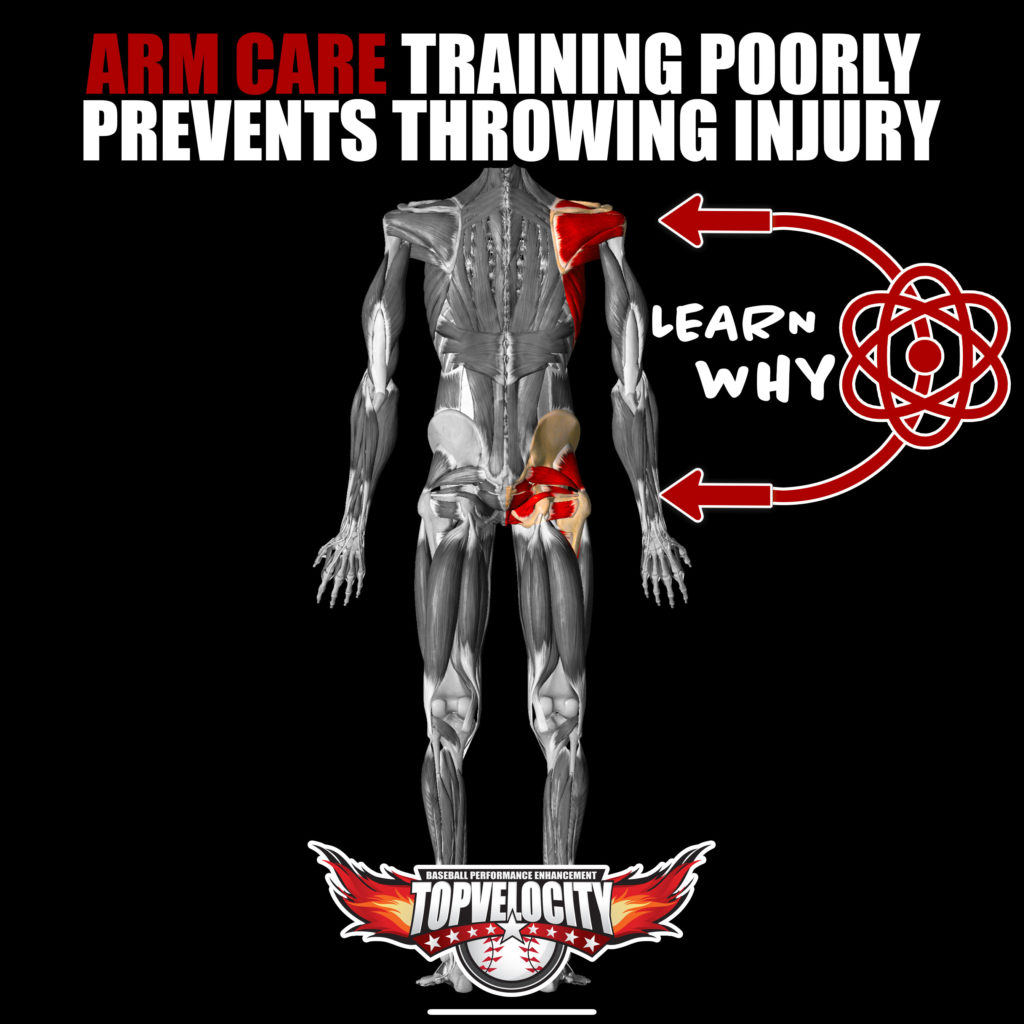
Has "Arm Care" training not helped you from preventing arm injury? A major challenge in the baseball coaching world is that the conventional wisdom is always trying to solve the arm injury problem in the game of baseball by just strengthening the arm. “Arm Care” programs are just that, programs that only care to strengthen the shoulder and sometimes the forearm. They completely ignore the lower extremity to upper extremity relationship within the kinetic chain and how it works together to reduce stress at the distal end. I have had experience working with pitchers who did a high volume of “Arm Care” training and still fell into serious arm injury. The key to “Arm Care” training successfully reducing arm injury is combining it with “Hip Care” training.
Better Science for Arm Care Training
Evidence suggests that in the baseball pitching motion, 50% of the energy that is transferred through the lumbopelvic-hip complex, shoulder, elbow, hand and ultimately the ball comes from the lower half (Kibler, Chandler, Shapiro, & Conuel, 2007; Kibler et al., 2013). The functional interaction of the lower extremity, lumbopelvic-hip complex and scapula is what determines the efficient dynamic movement of the upper extremity (Kibler et al., 2013). It is known that proper hip and pelvis orientation at lead foot contact (non-throwing side leg) requires adequate internal rotation of the stance leg (throwing side leg) and external rotation of the lead leg to allow the trunk to follow the hip and pelvis as the pitcher rotates to square to the target (Wilk et al., 2011). Segmental sequentiality of the kinetic chain is what allows for the trunk to follow the hip as the player rotates to square up to target (Dillman et al., 1993).
Evidence has reported a significant relationship between stance hip (throwing side leg) passive internal rotation following a simulated game pitching protocol and scapular tilt at the event of maximum humeral external rotation during the last inning of pitching. This relationship indicated that those who reported greater stance hip (throwing side leg) internal rotation at the completion of the pitching protocol also displayed less posterior scapular tilting during the last inning of pitching (Oliver, & Weimar, 2015). Additionally, a posterior tilt of the scapula has been suggested to allow for additional subacromial space as the humerus is abducted (McClure, Michener, Sennett, & Karduna, 2001). This additional subacromial space will help prevent shoulder impingements and will allow the scaps to transfer energy through the upper extremities more efficiently.
There are several studies that have found a moderate relationship between passive external rotation of the stance hip and posterior tilt and scapular upward rotation as well (Kibler, 1995; Kibler et al., 2007, 2013; Laudner, Myers, Pasquale, Bradley, & Lephart, 2006; Myers, 2005; Myers et al., 2013; Scher et al., 2010). Bilateral differences in shoulder total rotation and flexion had a significant effect on the risk of elbow injuries in pitchers (Wilk et al., 2015). This evidence suggests that hip external rotation flexibility is required for healthy overhead throwing and that hip flexibility and strength training should be a part of all “Arm Care” training programs.
Arm Care Training Reference
Dillman, C. J., Fleisig, G., & Andrews, J. R. (1993). Biomechanics of pitching with emphasis upon shoulder kinematics. Journal of Orthopaedic and Sports Physical Therapy, 18(2), 402-408.
Kibler, W. B. (1995). Pathophysiology of overload injuries around the elbow. Clinics in Sports Medicine, 14(2), 447-457.
Kibler, W. B., Chandler, T. J., Shapiro, R., & Conuel, M. (2007). Muscle activation in coupled scapulohumeral motions in the high performance tennis serve. British Journal of Sports Medicine, 41(11), 745-749.
Kibler, W. B., Wilkes, T., & Sciascia, A. (2013). Mechanics and pathomechanics in the overhead athlete. Clinics in Sports Medicine, 32(4), 637-651.
Laudner, K. G., Myers, J. B., Pasquale, M. R., Bradley, J. P., & Lephart, S. M. (2006). Scapular dysfunction in throwers with pathologic internal impingement. Journal of Orthopaedic and Sports Physical Therapy, 36(7), 485-494.
McClure, P. W., Michener, L. A., Sennett, B. J., & Karduna, A. R. (2001). Direct 3-dimensional measurement of scapular kinematics during dynamic movements in vivo. Journal of Shoulder and Elbow Surgery, 10(3), 269-277.
Myers, J. B. (2005). Scapular position and orientation in throwing athletes. American Journal of Sports Medicine, 33(2), 263-271.
Myers, J. B., Oyama, S., & Hibberd, E. E. (2013). Scapular dysfunction in high school baseball players sustaining throwing-related upper extremity injury: A prospective study. Journal of Shoulder and Elbow Surgery, 22(9), 1154-1159.
Oliver, G. D., & Weimar, W. (2015). Hip range of motion and scapula position in youth baseball pitching pre and post simulated game. Journal of Sports Sciences, 33(14), 1447-53.
Scher, S., Anderson, K., Weber, N., Bajorek, J., Rand, K., & Bey, M. J. (2010). Associations among hip and shoulder range of motion and shoulder injury in professional baseball players. Journal of Athletic Training, 45(2), 191-197.
Wilk, K. E., Macrina, L. C., Fleisig, G. S., Aune, K. T., Porterfield, R. A., Harker, P., … Andrews, J. R. (2015). Deficits in Glenohumeral Passive Range of Motion Increase Risk of Shoulder Injury in Professional Baseball Pitchers: A Prospective Study. American Journal of Sports Medicine, 43(10), 2379-85.
Wilk, K. E., Macrina, L. C., Fleisig, G. S., Porterfield, R., Simpson II, C. D., Harker, P., … Andrews, J. R. (2011). Correlation of glenohumeral internal rotation deficit and total rotational motion to shoulder injuries in professional baseball pitchers. The American Journal of Sports Medicine, 39(2), 329-335.



